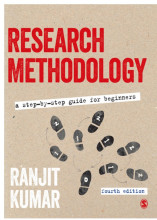Summary: Research Methodology
- This + 400k other summaries
- A unique study and practice tool
- Never study anything twice again
- Get the grades you hope for
- 100% sure, 100% understanding
Read the summary and the most important questions on Research Methodology
-
hoofdstuk 1
This is a preview. There are 21 more flashcards available for chapter 27/02/2021
Show more cards here -
Evidence-based practice (EBP)
A service delivery system that is based upon research evidence. -
hoofdstuk 4
This is a preview. There are 5 more flashcards available for chapter 27/02/2021
Show more cards here -
Considerations in selecting a research problem
Interest, magnitude, measurement of concepts, level of expertise, relevance, available data, ethical issues -
Steps in formulating a research problem
1. Identify abroad field
2. Dissect the broad area into subareas
3. Select what is most of interest
4. Raise a research question
5. Formulate objectives
6. Asses your objectives
7. Double check -
hoofdstuk 3
This is a preview. There are 21 more flashcards available for chapter 27/02/2021
Show more cards here -
Conducting a literature review
1. Search for the existing literature
2. Review the selected literature
3. Develop a theoretical framework: broad, general
4. Develop a conceptual framework: focusses on one of the problems found during the theoretical framework. -
hoofdstuk 11
This is a preview. There are 18 more flashcards available for chapter 27/02/2021
Show more cards here -
Face and content validity
Face validity; when you justify the inclusion of a question or item in a research instrument by linking it with the objectives of the study, this providing a justificarion for its inclusion in the instrument
content validity; examining the questions of a research instrument to establish the extent of covarage of areas under studying. -
Concurrent and predictive validity
Concurrent validity; when you investigate how good a research instrument is by comparing it with credible findings
predictive validity; judged by the degree to which an instrument can correctly forecast an outcome -> the higher the correctness the more valid the instrument is. -
Factors affecting reliability of a research instrument
Wording of questions, the physical setting, the respondents mood, the interviewers mood, nature of the interaction, regression effect -
Methods of determining reliability
- external consistency; compares findings from two independent processes of data collection with eachother as a means of verifying the reliability of the measure.
- internal consistency; intruments that measure the same phenomenon, if they are reliable indicators, should produce similar results irrespective of their measure attitude towards a problem. -
hoofdstuk 7
This is a preview. There are 4 more flashcards available for chapter 27/02/2021
Show more cards here -
Maximincon principle of variance
Ensuring that the independent variable has the maximum oppportunitu to have its full impact on the dependent variable, while the effects that are attributed to extraneous and chance variables are minimised. -
hoofdstuk 6
This is a preview. There are 6 more flashcards available for chapter 27/02/2021
Show more cards here -
Errors in testing hypothesis
Type 1 error: if you reject a null hypothesis when its true and you should not have rejected it
Type 2 error: if your reject a null hypothesis whens its false and you should not have rejected it
- Higher grades + faster learning
- Never study anything twice
- 100% sure, 100% understanding
































